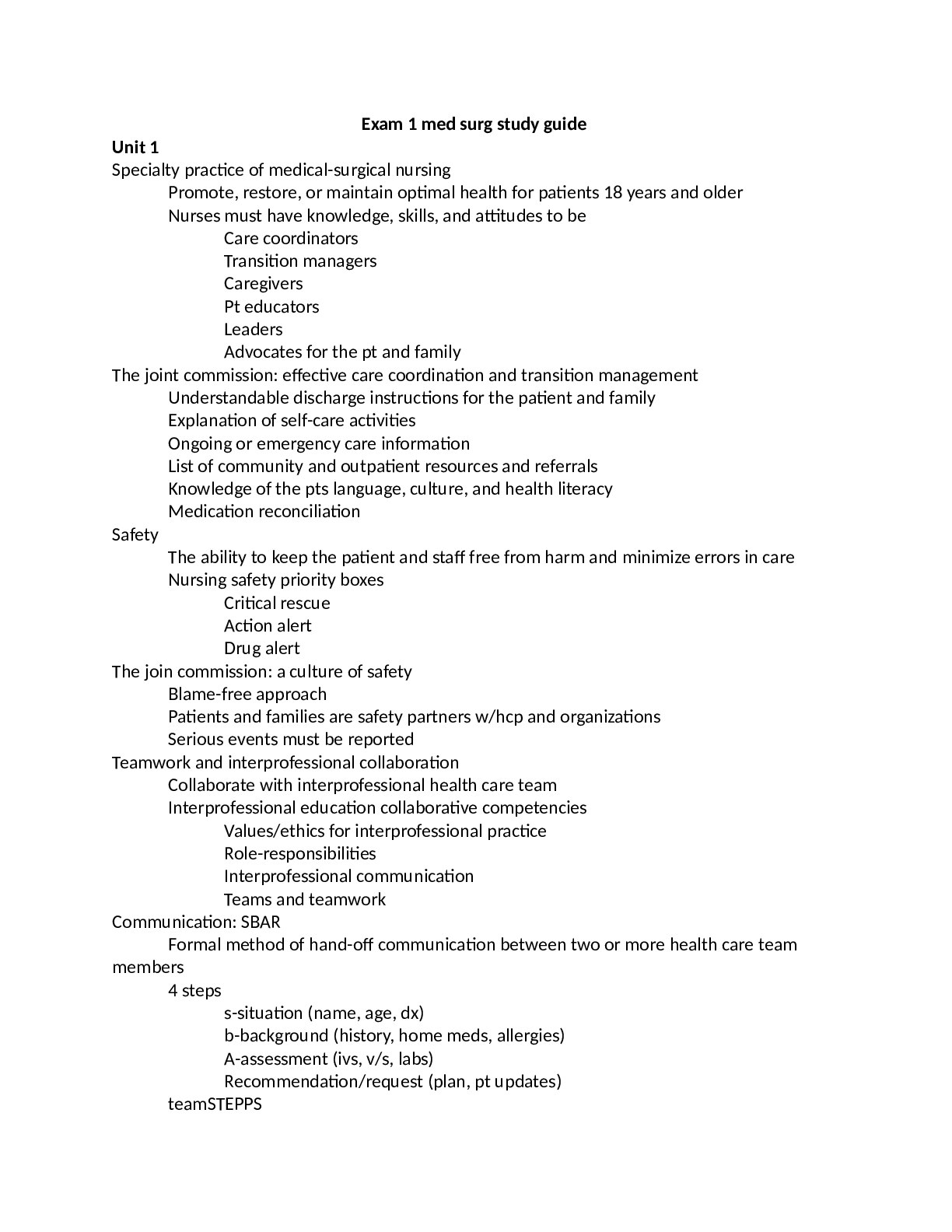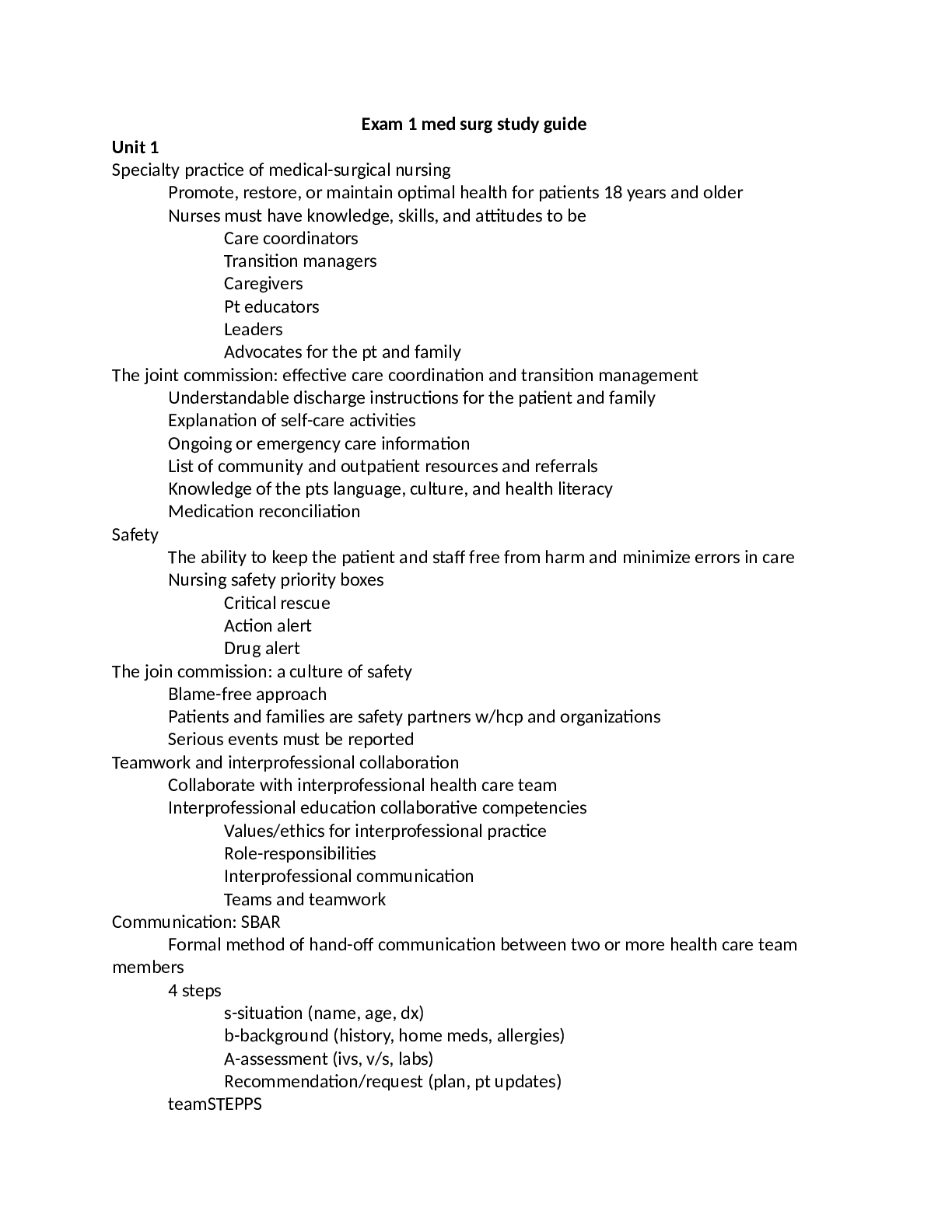Unit 1
Specialty practice of medical-surgical nursing
Promote, restore, or maintain optimal health for patients 18 years and older
Nurses must have knowledge, skills, and attitudes to be
Care coordinators
Transition managers
Caregivers
Pt educators
Leaders
Advocates for the pt and family
The joint commission: effective care coordination and transition management
Understandable discharge instructions for the patient and family
Explanation of self-care activities
Ongoing or emergency care information
List of community and outpatient resources and referrals
Knowledge of the pts language, culture, and health literacy
Medication reconciliation
Safety
The ability to keep the patient and staff free from harm and minimize errors in care
Nursing safety priority boxes
Critical rescue
Action alert
Drug alert
The join commission: a culture of safety
Blame-free approach
Patients and families are safety partners w/hcp and organizations
Serious events must be reported
Teamwork and interprofessional collaboration
Collaborate with interprofessional health care team
Interprofessional education collaborative competencies
Values/ethics for interprofessional practice
Role-responsibilities
Interprofessional communication
Teams and teamwork
Communication: SBAR
Formal method of hand-off communication between two or more health care team
members
4 steps
s-situation (name, age, dx)
b-background (history, home meds, allergies)
A-assessment (ivs, v/s, labs)
Recommendation/request (plan, pt updates)
teamSTEPPS
Delegation
Process of transferring a selected nursing task or activity to a competent UAP
(unlicensed assistive personnel)
The nurse is always accountable for the task/activity delegated!
Nugget**
Make sure they understand, and it is within their scope of practice!! Be specific
Prioritization and delegation
Physiological, psychological, acute, chronic, unstable, stable, unpredictable, predictable
Five rights of delegation
Right task
Right circumstances
Right person
Right communication
Right supervision
Supervision
Guidance or direction, evaluation, and followup by the nurse to ensure a task/activity is
performed appropriately
Evidence-based practice (EBP)
Integration of the best current evidence and practices to make decisions about patient
care
Considers patient preferences and values
Considers one own clinical expertise for delivery of optimal health care
Ethics
Addresses issues and questions about morality
Attributes
Autonomy
Beneficence
Nonmaleficence
Fidelity
Veracity
Social justice
Common health problems of older adults
Concepts
The priority concepts are mobility nutrition and cognition
Subgroups of late adulthood
Young old- 65 to 74 years
Middle old 75-84 years
Old old – 85 to 99 years
Elite old- 100 plus
Common health issues and concerns
Performance of adls
Participation in social activities
Losses
Health promotion
Special considerations for older adult clients
Decrease tolerance to meds
Decrease iv rate to avoid fluid overload
Increase risk of:
Respiratory depression
Pneumonia
Disorientation
Skin breakdown
Problems w/
Circulation
Nutrition
Constipation
Fluid and electrolyte balance
Increase balance and decrase falls
Sudden increase in confusion
Urine infection
Hypoxia
Electrolyte imbalance
Clinical management
Treat coexisting medical disorders
Cardiac problems
Pvd
Neurological disorders
Nugget**
Copd
Resp. issues
Common health issues and concerns
Impaired nutrition and hydration
Impaired mobility strokes, risk falls
Stress, loss, and coping
Accidents
Drug use and misuse
Impaired cognition
Substance use
Elder neglect and abuse
Nugget**
Depression
Health need: seeing MD as needed
Impaired nutrition and hydration
Increased need for calcium, vit a/c/d, fiber
Diminished taste and smell, tooth loss, poor dentures can impact nutrition status
Constipation concers
Loneliness
Skin breakdown
Nutrition support
Avoid friction, shearing
Reposition and provide support surfaces
Increase mobility and activity
Clean skin, use moisture barriers
Rehabilitation interprofessional team
Nurses, nursing assistants
Physicians and physician assistants
Advanced practice nurses
Physical therapists and assistants
OT and assistants
Speech-language pathologists and assistants
Neuropsychologists
Social workers
Psychologists
Spiritual care counselors
Registered dietitians
Pharmacists
Cardiovascular and respiratory assessment
Assess for decrease in cardiac output
Chest pain
Weakness and fatigue
Plan care to maximize limited energy resources
Frequent rest periods
Major tasks in morning
Determine level of activity that can be done without invoking symptoms
Nugget**
Fluid in lungs and DVTs
SOB
Crackles, rhonchi
Improving physical mobility
Safe patient handling practices
Position changes (bed to chair, commode, or wheelchair)
Provide assistance w/ transfers
Gait training
Use of assistive devices/ambulatory aids (canes and walkers)
Implementing ROM routines/exercises
Coordinate care w/PT and OT
Assess pts mobility levels using standardized tool
Nugget** look at chart 6-1
Canes and walkers**
Cane opposite affected leg (COAL)
Walker, with, affected leg (wandering Wilma’s always late)
Skin and tissue integrity assessment
Read More


